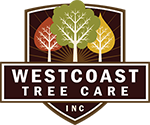It’s an unfortunate reality that falling trees usually come to the surprise of an unsuspecting homeowner. While most of us think it must take hurricane force winds to completely uproot a tree, nothing could be farther from the truth. In fact, trees are susceptible to a wide variety of factors that can cause them to fail. Some of these include storm damage, insect infestation, malnutrition, poor soil conditions, flooding, old age, construction damage, and improper planting conditions just to name a few.
While predicting when a tree is going to fail is impossible, it’s easier to spot some early warning signs before it’s too late. That’s why Westcoast Tree Care would like to provide you with the following tree care signs for diagnosing a hazardous tree.
Tree Care Warning Signs:
Visible Dead Branches
While dead, visible branches don’t necessarily indicate a tree is going to fall over, it does present the potential for a hazardous situation. Dead branches have the ability to fall unexpectedly causing extensive harm or damage to your property. Dead branches are also a good indication that something is affecting the overall health of a tree. That’s why it’s important to have a tree pruned and inspected by a certified arborist to prevent a dangerous situation from happening while assessing the overall health of a tree.
Cracks & Cavities
Two side effects of a tree shedding dead branches is the formation of cracks or cavities inside its trunk. When a dead branch breaks away from a tree, the open wound left behind can lead to lead to unwanted insect infestations or disease. While cracks and cavities don’t necessarily indicate your tree is going to fail, it could lead to its ultimate demise down the road. That’s why it’s important to consult with a tree care professional should you spot either of these warning signs.
Missing Bark
Another warning sign that may indicate a hazardous tree is missing patches of bark (other wise known as cankers) on the trunk of your tree. The presence of cankers can be caused by damage due to insects, weed eaters, or environmental conditions making it highly vulnerable to bacteria, disease or fungus. While cankers may not be enough to warrant the removal of an entire tree, it’s important to have a preventative tree care inspection done by a certified arborist to see what measures need to be taken to protect your tree.
V-Shaped Unions
Strong, healthy branches usually have an ideal distance between them so there’s enough room to grow and develop. Branches that grow too close together, however, can develop a V-shaped union. A V-shaped union is a deformity that can lead to a dangerous crack between two main branches. When this happens, a tree can become a hazardous threat to everyone and everything around it.
Root Damage & Decay
While harder to spot than any other hazardous tree sign, root damage or decay can render a tree unsafe. Signs to look out for include mounds or bulging in the soil around the base of the tree, visible dead and rotting roots, an increased lean or a decline in the tree canopy. It’s also a good idea to inspect your tree for mushrooms or other fungi around its base. In either case, it’s important to consult with a certified arborist to figure out the best course of action.
Preventative Tree Care
It’s important to pay attention to any indications of a hazardous tree. Keep in mind that many signs are often subtle or even undetectable to the untrained eye. If you suspect your tree may be diseased, damaged or dying, contact Westcoast Tree Care at 1.800.767.8733. Our certified arborist can help diagnose a variety of tree care problems and answer any questions you may have. We will also provide you with a no-cost, no-obligation quote for any of our preventative tree care services.








